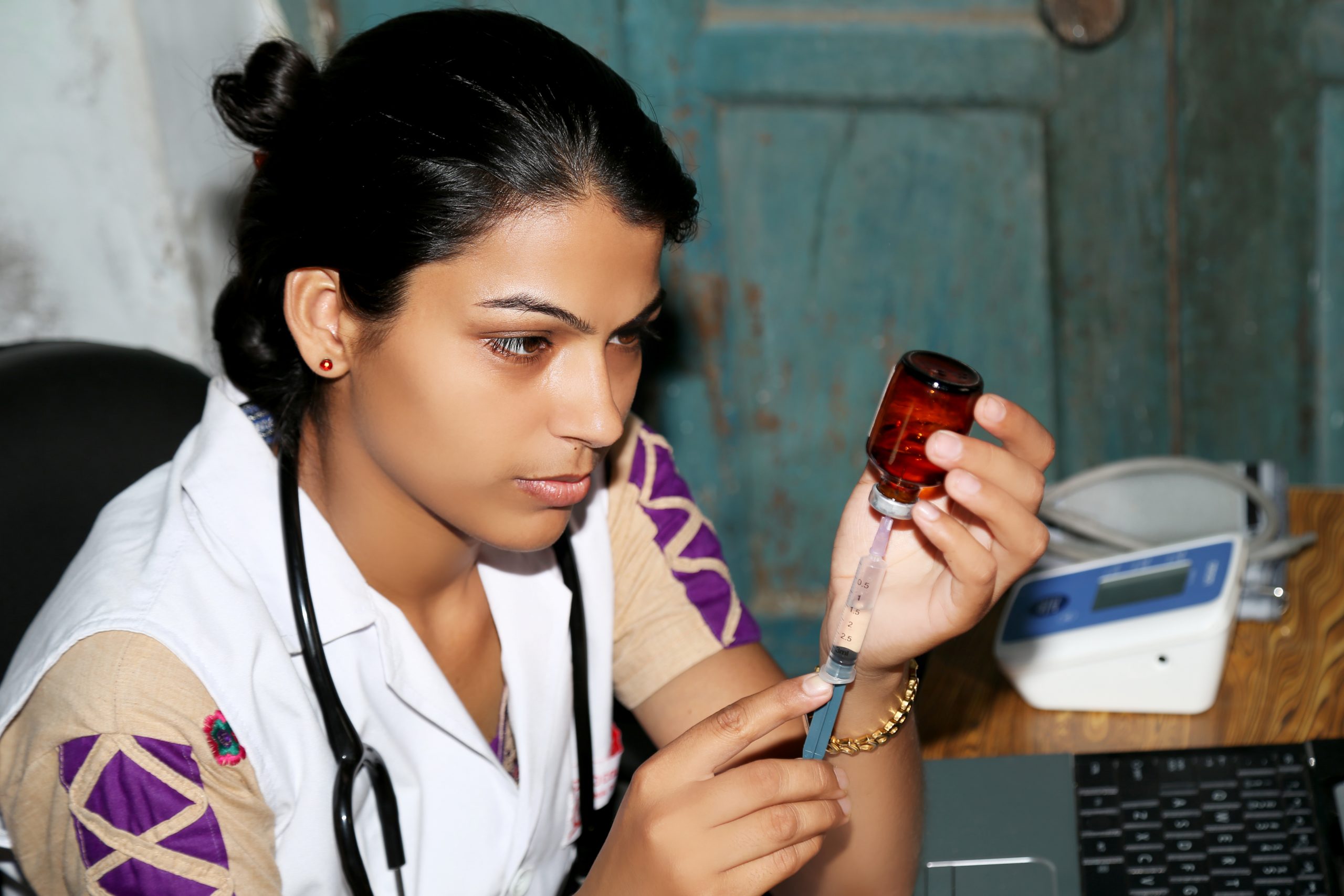
Context
Cervical cancer is the second leading cause of cancer deaths among women in India. The human papillomavirus (HPV) vaccine, which can prevent cervical cancer, was introduced in 2008 in India and is recommended for adolescent girls between the ages of 9-14 years. But since its inception, the uptake and administration of the HPV vaccine has been low.
There are multiple reasons for the low uptake, including policy challenges associated with vaccine approval and low awareness of the risks of HPV infections among the general population. Our research found that physicians in India display varying levels of hesitancy when it comes to recommending the HPV vaccine, which contributes to the low awareness and poor conviction among parents/guardians to vaccinate their children. With parents/guardians perceiving physicians as one of the most trusted sources of health information, improving physician confidence in recommending the HPV vaccine can increase the likelihood of more parents choosing to protect their girls through HPV vaccination.
Project
To increase the uptake of the HPV vaccine in India, behavioural research was led by the Center for Social and Behaviour Change at Ashoka University to a) understand the sources of hesitancy among physicians related to the HPV vaccine, and b) develop and test behaviour change communication solutions to reduce physician hesitancy in recommending the HPV vaccine. Read the full research report here.
The scope of this study was three-fold, consisting of:
- A formative research study conducted with physicians, adolescent girls, their parents/guardians, and community influencers in West Bengal to explore barriers and facilitators to physician recommendation of the HPV vaccine: 97 interviews.
- Design and review of multiple communication nudges and interventions with physicians addressing different behavioural biases identified during the HPV vaccine barrier research.
- Testing five communication nudges and behavioural interventions (solutions) with 616 physicians in West Bengal.
Behavioural Assessment
The behavioural assessment identified multiple behavioural biases that affect physicians’ decision-making around HPV vaccination.
Availability and optimism bias: Physicians underestimate the prevalence and the threat of HPV infection and cervical cancer and therefore the importance and necessity of the HPV vaccine.
- Most physicians reported that they do not commonly see cervical cancer cases, contributing to their underestimation of the disease and the perception that it is not an issue needing to be discussed with their patients.
- Physicians believed the incidence of cervical cancer to be higher among women of lower socioeconomic categories, rural areas, and/or who were seen as following “sexually unsafe” practices. This leads them to be more optimistic about their “regular” patients, incorrectly believing that they would not be at high risk of HPV infection.
Skewed perception of trust: Physicians display a lack of trust in the safety and efficacy of the HPV vaccine.
- Physicians expressed mixed views on the effectiveness of the vaccine in preventing cervical cancer. Concerns about the vaccine included perceived adverse effects such as the impact on future fertility and the risk of congenital abnormalities in future children. There was also confusion about the vaccine’s dosing schedule for different age groups and previous non-inclusion in the country’s Universal Immunisation Programme (IUP).
- Some physicians believe that the push for the vaccine is driven by the economic interests of vaccine manufacturers rather than the health benefits for the general public.
Concern of breaking social norms: Physicians find it difficult to converse about the HPV vaccine or bring up words like cancer with parents of young girls.
- Given that HPV is primarily transmitted through sexual activity, physicians reported finding it difficult to easily initiate conversation and counsel parents on cervical cancer and its risk factors due to existing cultural norms in India that view these practices as taboo or immoral.
- Physicians also report that topics such as cancer cause a certain level of discomfort among parents, particularly when discussed in relation to adolescents. Additionally, discussing vaccination for adolescents is seen as being difficult due to a certain vaccine fatigue that is reached among parents by the time their children reach adolescence.
Behavioural Design: Co-Designing Solutions to Address Physician Biases
We designed communication nudges and behavioural interventions (solutions) that directly targeted the three physician biases that result in physician hesitancy to recommend the HPV vaccine. A design workshop held with key stakeholders from public health, medical societies, cancer organisations, and academia generated ideas for solutions that were later refined. The following five solutions were selected for an evaluation study. For each solution, a video and poster were produced.
Endorsement by a trusted medical champion
Concept: Leveraging the transitive nature of trust, an endorsement of the vaccine’s safety and efficacy by a trusted, well-known medical professional (referred to as a champion) can then result in the “rollover” of trust from the individual to the vaccine they recommend.
Target bias: Low Trust
Solution: Feature Dr. Soumya Swaminathan, former Chief Scientist, WHO, highlighting the risks of cervical cancer and the safety and efficacy of the HPV vaccine.
Refreshing the dangers of cervical cancer and the ease of prevention
Concept: By making prominent the nature and extent of the problem (cervical cancer) and the role of physicians in solving it (by promoting HPV vaccine), we can change current beliefs about the problem.
Target bias: Underestimation of the Risk of HPV
Solution: Highlight the danger of HPV and cervical cancer in India and the deaths from it, then reinforce that a preventive solution exists by offering facts about HPV vaccine safety and effectiveness.
Icebreakers for sensitive conversations
Concept: Provide doctors with simple social cues and examples for initiating conversations on the HPV vaccine that can make discussions with parents less awkward.
Target bias: Breaking social norms (ways to make the HPV vaccine recommendation easy)
Solution: Explain the cues and demonstrate three different conversation techniques a doctor can use to talk about the HPV vaccine with the parents of an adolescent girl.
Introducing environmental cues to initiate conversation
Concept: Use an environmental cue to initiate the conversation outside of the two main parties (the doctor and the patient) – making it less awkward.
Target bias: Breaking social norms (ways to make the HPV vaccine recommendation easy)
Solution: Use a poster urging doctors to talk about the HPV vaccine with parents/patients to protect their patients’ health (the environmental cue) to initiate discussion about the HPV vaccine during a doctor-parent/patient interaction.
Bundling the HPV recommendation with other recommendations
Concept: Bundling a sensitive topic with a non-sensitive one can lead to a coupling effect and neutralise the conversation. By bundling the HPV vaccine with the Td/Tdap vaccine, doctors can neutralise the conversation to a more generic topic on vaccination and encourage parents/patients to adopt both.
Target bias: Breaking social norms (ways to make the HPV vaccine recommendation easy)
Solution: Using a prescription notepad that included appointment dates for both the HPV vaccine and the Td/Tdap vaccine, the doctor could bundle the conversation on both vaccines, making it easier for the parent to accept both.
Evaluating Solutions
The five selected behavioural solutions were evaluated using a survey-based experiment methodology. Due to the COVID-19 pandemic, the study protocols were adapted to remote methods. The overall sample consisted of 616 physicians (paediatricians, gynaecologists, and general physicians).
Trained enumerators recruited physicians through purposive sampling. Doctors first answered a baseline survey, viewed the assigned video and poster (referred to as solutions above), answered a post-survey, and received a follow-up call/email one week later. Assignment to the solution was completely randomised, with an equal probability of being assigned to each of the five solutions and the two control stimuli.
The effectiveness of the solutions was assessed by understanding the causal effect of the solution on physicians’:
- Primary outcome: intent to recommend the HPV vaccine and sustain intention to recommend
- Secondary outcomes: trust in the HPV vaccine, self-efficacy in having conversations about the vaccine, and perceptions, knowledge, and self-efficacy as they relate to the vaccine

Results
The evaluation study found that the solutions of “Refreshing the Dangers of Cervical Cancer and the Ease of Prevention” and “Endorsement by a Trusted Medical Champion” can significantly boost physicians’ intention to recommend the HPV vaccine. Each of these solutions demonstrated a 100% increase in the likelihood of the physician expressing an intention to recommend the HPV vaccine.
These solutions had limited statistically significant results on the secondary outcome variables of perception, knowledge, attitudes of trust, and self-efficacy, except for the endorsement solution which significantly increased knowledge.
Translating Insights into Action
To increase the uptake of the HPV vaccine in India, consider incorporating the following solutions and messages into any HPV vaccine education efforts with physicians:
- Remind physicians of the dangers and risks associated with HPV, the burden of cervical cancer, and the ease of prevention through vaccines. The risks of HPV might not be most prominent for physicians who are dealing with multiple health issues. Regular emphasis on the issue, along with presenting the vaccine as a simple solution can encourage them to initiate the conversation with parents/patients.
- Have well-known physician champions endorse the HPV vaccine. Build trust in the HPV vaccine by having well-known medical professionals endorse it publicly. Such endorsements can help physicians move past uncertainty and more confidently encourage the vaccine to parents/patients.
- Emphasise to physicians that they have a responsibility to protect their patients from the risks of cervical cancer. Physicians need to understand that their limited encouragement or counselling on the HPV vaccine could put their patients at risk.
Lastly, it is important for policymakers to understand how physicians/providers can also be subject to behavioural biases that might result in poor health outcomes. Physicians/providers are often overburdened by competing priorities and cannot always work optimally. Simple solutions or nudges like the ones discovered for the HPV vaccine can help physicians shift away from their biases and hesitancy and provide the best medical care for their patients.
